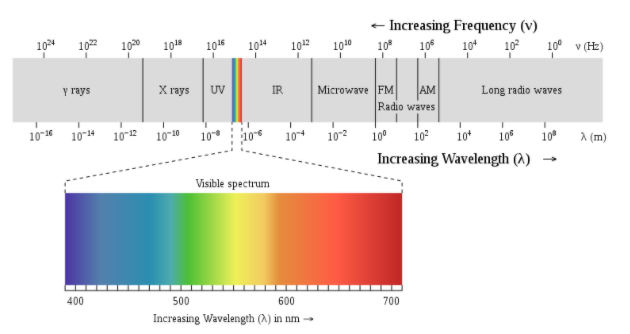Question
Question: Indigo and Red regions of VIBGYOR, respectively fall in range of wavelength? A. \(430 - 470\) nm a...
Indigo and Red regions of VIBGYOR, respectively fall in range of wavelength?
A. 430−470 nm and 660−760 nm
B. 300−390 nm and 600−650 nm
C. 390−760 nm and 430−470 nm
D. 660−760 nm and 430−470 nm
Solution
VIBGYOR contains seven colours. Violet exhibits the shortest wavelength whereas red has the longest one. These colours come under the visible spectrum starting from the wavelength 400 nm and end up to 700 nm. Indigo is the colour that comes after the colour Violet in the spectrum and red comes at last.
Complete answer:
-VIBGYOR stands for colours that we can observe in the rainbow-
V stand for Violet (wavelength 400 nm)
I stand for Indigo (wavelength 425 nm)
B stands for Blue (wavelength 470 nm)
G stand for Green (wavelength 550 nm)
Y stands for Yellow (wavelength 600 nm)
O stand for Orange (wavelength 630 nm)
R stands for Red (wavelength 665 nm)
-When all of the colours are combined, we get white light that we can see coming from the sun or a light source.
-Red colour exhibits the longest wavelength while Violet colour exhibits the shortest one.
-The wavelength that reflects our eyes, tells us the colour of an object.
-Our eyes can only detect the visible region of the electromagnetic spectrum. Depending on the wavelength, we can differentiate between different colours.
-Red colour can be detected if the wavelength is 600−760 nm and the shortest wavelength 400−430 nm can be noticed as the colour violet.
-Light is also called “Polychromatic” because it is a mixture of all of the colours known as “VIBGYOR”.
-On the other hand, lasers are ‘monochromatic’ light and contain the light of only one wavelength and can cause severe damage to our eyes.
-The colours that the object’s molecules reflect, tell us the colour of the object. For example, an apple is red because the molecules of the apple absorb all other colours except the colour “red”. Same goes for the green t-shirt your friend is wearing or the blackboard (black absorbs all of the colours and reflects no colour so it’s black).
-Our eyes are capable of perceiving colours because they contain photoreceptors known as rods and cones. Rods are responsible for white, grey and black colour perception while cones are responsible to receive other colours.

Hence, the correct answer is option (A).
Note: The electromagnetic radiation spectra depict different types of radiations or waves which differ in the matter of their wavelengths and their intensity. There is a small portion of the spectra that is visible to our eyes and that spectrum is known as “Visible Range” because our eyes can perceive that part of the spectrum. The intensity of the colour can be explained with the example - the low-intensity yellow-orange is seen as brown and a low-intensity yellow-green can be referred to as the olive green colour.
